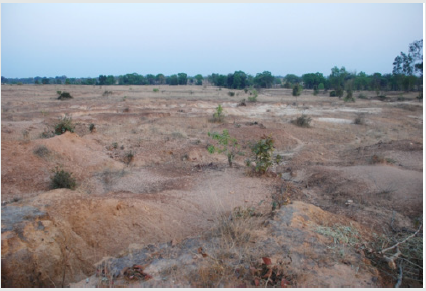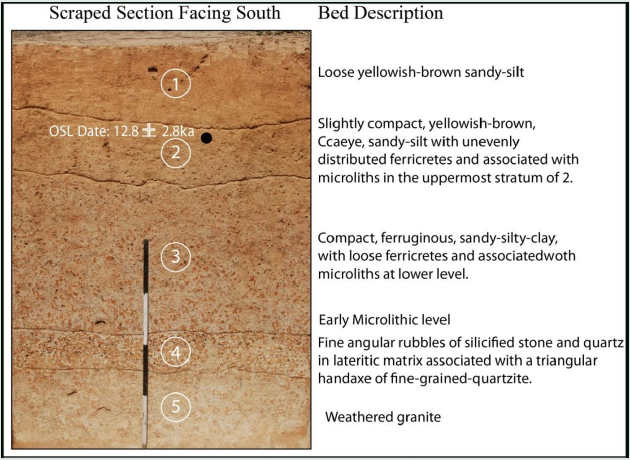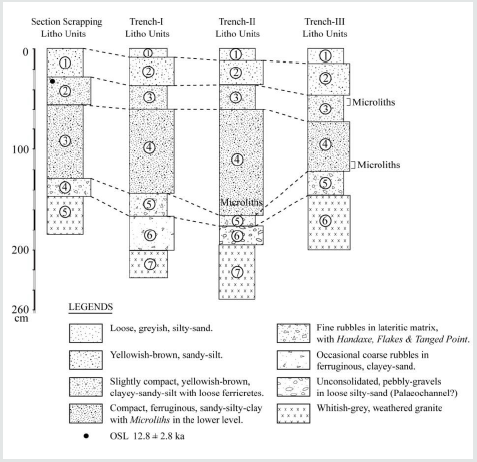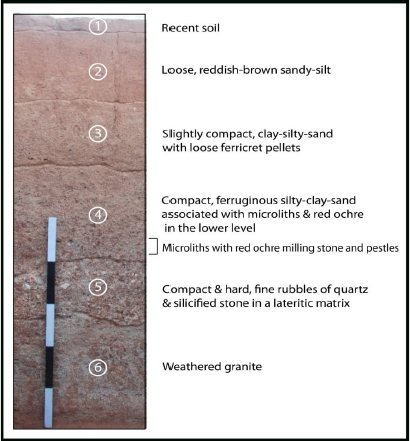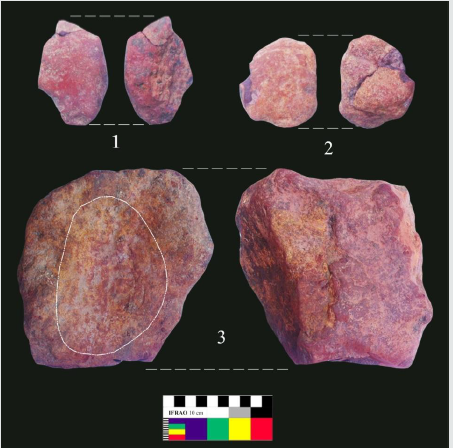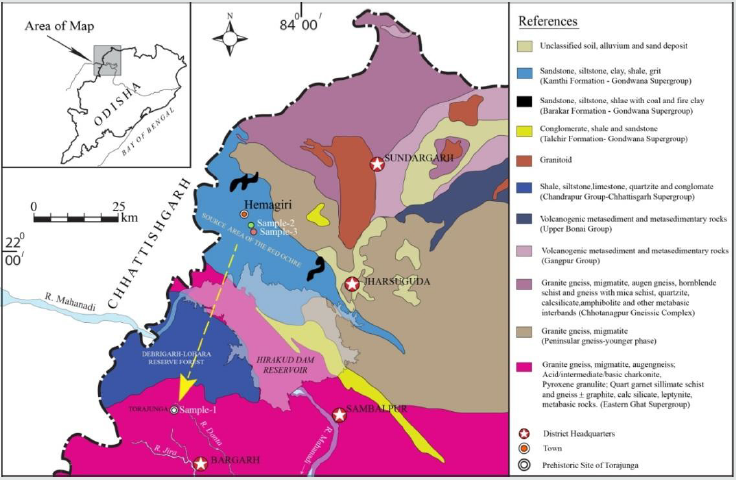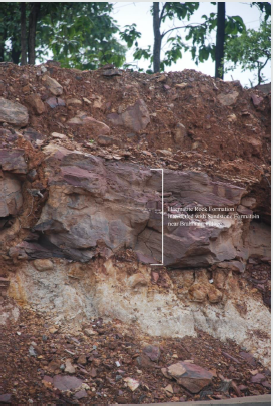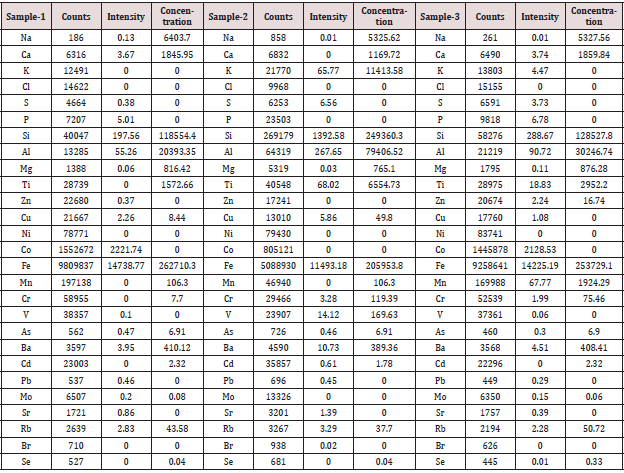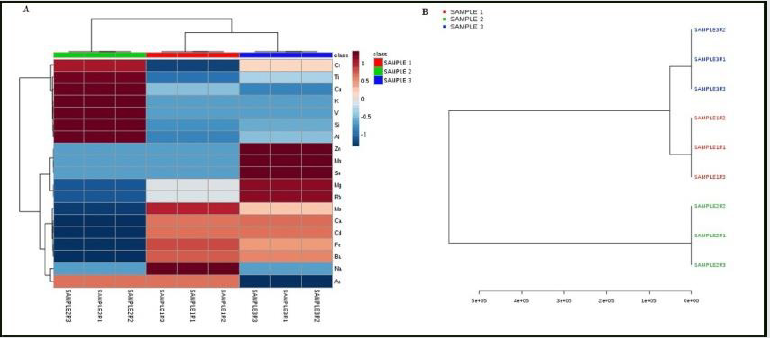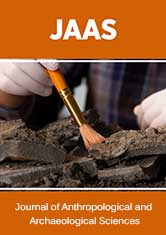
Lupine Publishers Group
Lupine Publishers
Menu
ISSN: 2690-5752
Research Article(ISSN: 2690-5752) 
Sourcing Used Red Ochre in the Late Middle Palaeolithic Context at Torajunga, Bargarh Uplands, Odisha, India: Results of Preliminary Investigation Volume 2 - Issue 4
Pradeep K Behera1*, M Sudershan2 and Neena Thakur1
- 1Department of History, Sambalpur University, Jyoti Vihar Burla, Odisha, India
- 2Senior Scientist, UGC-DAE CSR Centre, Kolkata, India
Received: July 20, 2020 Published: September 08, 2020
Corresponding author: Pradeep K Behera, Post-Graduate Department of History, Sambalpur University, Jyoti Vihar Burla, Odisha, India
DOI: 10.32474/JAAS.2020.02.000145
Abstract
Red ochre or hydrated iron oxide widely used by the H. sapience since the Middle Palaeolithic/Middle Stone Age times or even earlier, is often considered as one of the most significant proxies of early/modern human behavior, emergence of symbolic behavior and advanced cognitive abilities in the prehistoric material records. In the present paper we tried to explain the geo-archaeological contexts of the occurrence of red ochre milling stone with pestles and made a preliminary attempt to trace the source area of this material. Results of our analysis clearly shows that red ochre blocks/pebbles were imported from distant sources from fro about 60-70 kilometers away from the open-air site of Torajunga for manufacturing powders, purpose of which is still little understood. However, ethnographic and archaeological sources have been used to possible use of this material at the site.
Keywords: Late middle Palaeolithic; Red Ochre; Provenance Study; Torajunga; Bargarh uplands; Odisha
Introduction
Although procurement and use of red ochre/haematite (α-Fe2O3) date back to the Lower Palaeolithic times [1], several early and late Middle Stone Age sites in Africa provided evidence for use of red ochre dating back to about more than 200-300 ka onwards [1-10]. In Europe recent studies have shown more than forty Middle Palaeolithic sites associated with possible red ochre/manganese oxide pigment use between MIS 6 and 3 time range, from at least 60-40 ka onwards [11-13]. Significantly, the Maastricht-Belvedere site in The Netherlands and the Benzu rock shelter in Spain [14] have produced evidence for use of this mineral by the Early Neanderthals dating back to about 200–250 ka (MIS 7). Recent debates have focused on the nature of human behavioral evolution in the Middle-Late Pleistocene period and use of red ochre is considered as one of the indicators of development of early symbolic behavior among the early/modern hominins [7, 15-21]. Recently, a large number of Late Palaeolithic open-air and rock shelter sites have been reported and studied from across South Asia [22-29]. However, evidence for red ochre/iron oxide use at open air sites in the Late Pleistocene context has not yet been reported from most of these microlith-bearing sites in South Asia. At Jwalapuram, Locality-9 rock shelter, striated red ochre crayon with several grinding facets have been reported from N3, Level 34, Stratum C/D interface, belonging to the Late Pleistocene sedimentary context dating back to about 34–33 BP [23]. Use of red ochre in the Late Pleistocene cultural contexts has also been widely reported from Sri Lanka but, in most of the cases those have been documented from cave and/or rock shelter sites, leaving large gaps in our understanding pertaining to the use of this mineral in the open-air site contexts.
of our Recent prehistoric investigation at the site of Torajunga in the Bargarh Upland of Odisha has brought to light, for the first time, evidence for systematic use of red ochre from the Late Pleistocene microlith-bearing sedimentary context, overlying the typical early Middle Palaeolithic deposit, characterized by the occurrence of small-medium-sized handaxes and cleavers (50-100mm), besides blades and blade cores, and Levallois cores, tanged points, discoids, etc. [30,31]. This paper aims at presenting the results recent investigation carried out at the site of Torajunga in the Bargarh uplands with particular reference to the early use of red ochre in the Late Palaeolithic/Pleistocene period.
The Area and its Physical Settings
The Bargarh uplands, spreading about 5837 square kilometer area, occupies the westernmost part of the state of Odisha bordering the eastern part of the Chhattisgarh state. Physiographically,the upland is divided into two distinct units, namely, the northern and north-western area represented by rugged denudational hills of varying elevation, from 190->600m above mean sea level, and a vast pedimented surface with isolated inselbergs gradually sloping towards the east up to the river Mahanadi (Figure 1). The area forms a part of the plateau region comprising several rows of dissected hills with a nearly north-south alignment. Geologically, three types of litho assemblages are represented in the area (Figure 2), namely, i) Gondwana Supergroup (Talchir Formation) of Carboniferous (?) /Permian age, ii) Chhattisgarh Supergroup (Chandarpur Group) of Middle to Upper Proterozoic age, rock formations of Proterozoic age, and Eastern Ghat Super Group (Khondolite Group) of Archaean age [32]. While the Easter Ghats rocks comprising charnockite, quartzite, khondolite and garnetiferous granite gneiss occur in the vast eastern part of the upland, the Chhattisgarh Group of rocks are represented by quartzite, silt stone, shale and limestone which have been intruded at places by dolerite dykes and quartz veins. At several places massive chert beds/dykes of blackish/grayish/ greenish colours have also been found. The area has undergone intense tectonic deformations, as evident by the presence of numerous faults and joints in the granitic rocks. Many of the fault zones are silicified and some are filled with quartz veins. The silicified rocks are massive, fine-grained and are of various colours, from dirty white, yellowish to brown.The granitic terrain is weathered to varying depths at different places leaving behind isolated patches of unweathered rocks. The massive weathering has given rise to the formation of the extensive pedeplain in the region. The upland is not a leveled tract, but an expanse of undulating country sloping down from the Saraidamak-Debrigarh- Lohara massif in the north-west and north to the Mahanadi valley in the east and south-east. Thin to thick quaternary deposits overlie the eroded and weathered granitic basement with a prominent unconformity [33]. The Quaternary deposits have undergone largescale erosion at many places, particularly in the western part of the upland, which is evident from the presence of numerous alluvium filled palaeo-channels thatcut across the deposits.
Figure 1: A General View of Topographic Features of the Northern Sector of Bargarh Upland drain by the river Jira.

In terms of drainage system, the Bargarh uplands may be
divided into two segments, as the northern sector is drained by the
river Jira and its tributaries, the southern sector is drained by the
Ong and its tributary rivers, and perennial as well as ephemeral
streams. The present area of investigation lies in the Jira river valley
system which is a major western tributary of the river Mahanadi.
Except the Jira all other major tributaries of this river, like the
Jhaun, Danta, etc., originate from the Debrigarh-Lohara massif lying
towards the northern part of the Bargarh upland (Figure 1).
While dense woodland forest of dry deciduous type is presently
confined to the hilly areas, the vast pediment is covered mostly with
shrubs and agricultural farm lands (Figure 3). The forest of this area abound in a variety of small to large wild game animals, besides
carnivores. The climate is hot, dry and arid, and during summer,
the temperature rises up to 48ºC and in winter mercurydrops to
around 7ºC. The rainfall is moderate to heavy with annual average
of 1500mm .
Figure 2: General geological formation found in the Northern Sector of Bargarh Upland, and Jharsuguda and Sundargarh districts of Odisha.
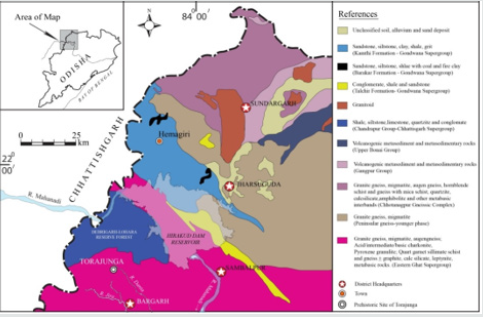
Figure 3: Map showing Land Use Pattern in Odisha with particular reference to the Study Area (Source-ORSAC).
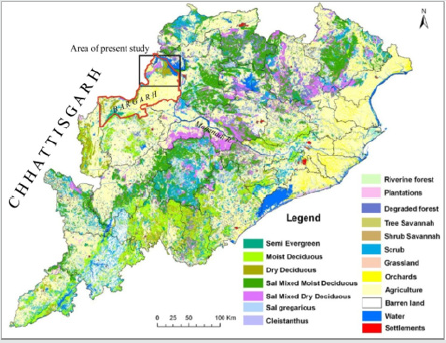
Materials and Methods
Our intensive investigation in the northern sector of the Bargarh uplands, particularly in the upper courses of the Danta and other tributaries of the Jira, brought to light a large number of localities associated with Late Acheulian-Middle Palaeolithic/microlithic assemblages with dense to thin scatters of lithic materials exposed on the surface in primary/semi-primary contexts (Figure 4). Only two sites have been subjected to limited excavations, viz., Barpadar (21º 22’59.88”N; 83º29’20.87” E) on Jira [34] and the site of Torajunga (21º29´22.70´´N; 83º32´ 23.11´´E), which is located on the upper course of the Danta stream, a tributary of the Jira. The site is relatively well preserved with intact physical condition and without any evidence for fluvial intervention (Figure 5); however major part of the southern part is badly eroded with reel and gully erosion (Figure 6) with scatter of artefacts exposed on the surface. The site was selected for limited excavations between 2015 and 2018. In 2015 a detailed survey and documentation of exposed surface artefact scatters was carried out in and around the site [31], which resulted in the discovery of 670 artefacts of Early- Late Middle Palaeolithic phases, represented by small to medium sized bifaces, a variety of scrapers, denticulates, notched tools, awls, burins, tanged points, etc., besides Levallois, Kombewa and flake-blade cores, all made out of medium-fine grained quartzite, as well as flakes-blades and microliths of cryptocrystalline silica group of rocks, particularly locally available chert (Figure 7).The site is located about 250 meterssouth of the right bank of the Danta stream, the channel bed (Elevation: 191m amsl) of which is about fifteen meters below the highest point of the site with elevation of 206m amsl. In 2015 an exposed section was thoroughly scrapped to determine culture sequence and stratigraphic succession (Figure 8). The upper level of litho unit-2, yielded microliths of quartz and chert and dated by OSL to 12.8 ± 2.8 ka (TBO-1). Subsequently, three trial trenches were taken east of the undisturbed surface, a comparative lithostratigraphy of which is given in Figure 9. Although microliths of chert and milky quartz occur in almost all the excavated trenches overlying sedimentary unit of fine-coarse rubble in lateritic matrix associated with Early Middle Palaeolithic artefacts, Trench-III is particularly significant for yielding red ochre milling-stone and used pestles on a floor associated with microliths (Figure 10). Based on the colour, texture, compactness and material remains, six sedimentary units could be identified (Figure 11). While stratum five, with a thickness of about 25-30cm, composed of fine to coarse rubbles in a lateritic matrix yielded thoroughly prepared miniature handaxe of triangular shape, besides tanged point and a few flakes including scrapers with semi-invasive retouching, all made out of medium to fine grained quartzite, the overlying deposit (Stratum-4), particularly from the lower level with a thickness of about 15-20cm yielded flakes-blades, bladelets, backed bladelets, lunates and other artefacts made out of chert, milky quartz and a few quartz crystal. An activity floor was detected at a depth of 110cm with scatter of lithic materials (Figure 12). Significantly, the assemblage recovered from above the Stratum-5 did not yield any artefact ofquartzite. Interestingly, the chert used in the manufacture of tools and otherartefacts were locally procured, several exposed beds of which have been documented nearby the area, adjacent to the southern flank of the Debrigarh-Lohara massif during our survey.
Figure 4: Distribution of Late Acheulian-Middle Palaeolithic/Microlithic Assemblages in the Northern Sector of Bargarh Upland.
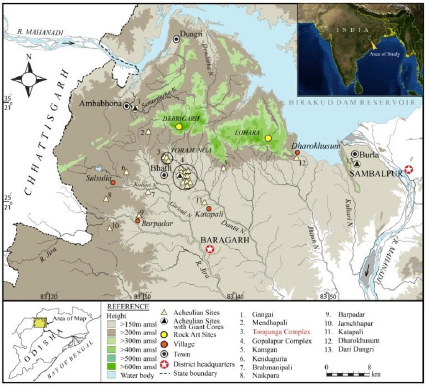
Figure 5: A-Site Map of Torajunga, B- Topographic Features of the Site with the Location of Trench-III.
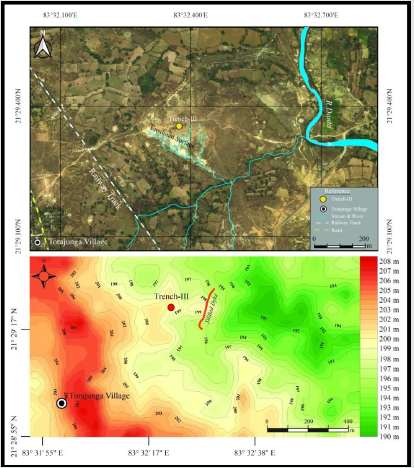
Figure 7: Artifact belonging to the early Middle Palaeolithic/Microlithic (A,B,C) and concentration of exposed Flake-Blade of Chert on the eroded surface.
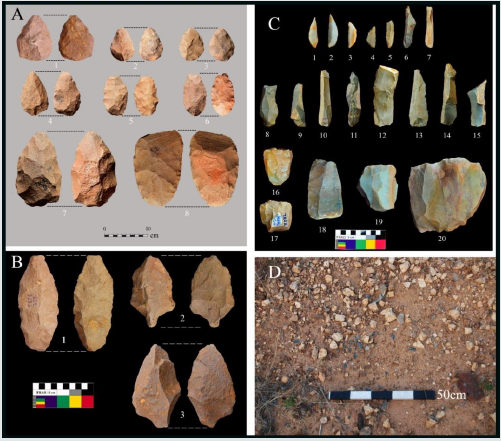
Figure 10: A- General View of the Excavation of Trench-III, B- View of the Working Floor at a depth of 110m from the surface with the Location of Ochre milling stone along with Microliths.
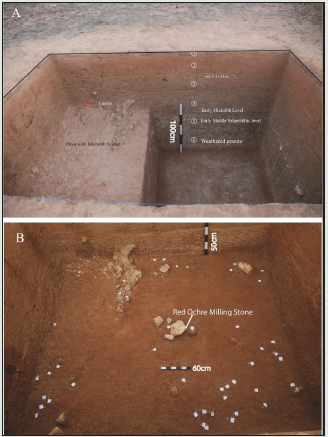
Figure 12: Scatters of Lithic Artifacts/Microliths along with the location of Used Red Ochre Blocks.
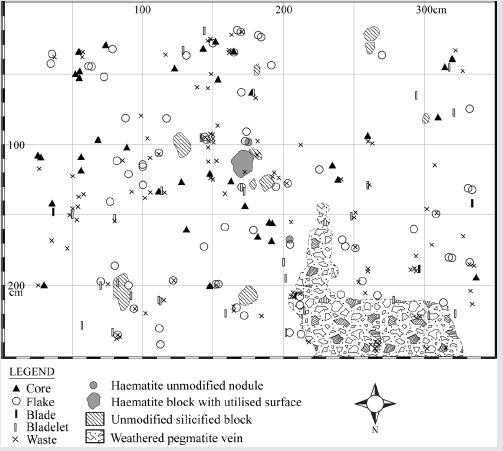
The activity floor exposed at a depth of 110cm has yielded a large roughly rectangular-shaped lump of used grinding block/ milling stone of red ochre with ground shallow surface on one of the faces and two small ovaloid-shaped used polishers/pestles, which were found beneath the grinding stone (Figure 13). The details of these specimens are given in the Table 1. The available evidence clearly suggests production of red ochre powder through grinding technique at this site.
Table 1. Metric and surface observation on the three used red ochre specimens, retrieved from the working floor of Trench-III.

In order to determine the provenance of red ochre/haematite deposit in the Bargarh upland, a detailed investigation was carried out, by using geological maps and other sources, like GIS and Geological Survey of India data base. Our study reveals that the lithological composition ofthis area does not include red ochre/ haematite formation. However, wide occurrence of haematite formations are reported from the southern part of the adjoining Sundargarh-Jharsuguda districts, where huge deposits of red ochre of different colours, like deep purple to light orange and red, occur in primary as well as secondary contexts in the form of pebbles, cobbles, boulders on the stream channel beds and stratified interbedded thick deposit. Geologically, these deposits occur in the Kamthi Formation of Gondwana Super Group belonging to the Permian to Triassic age. This is possibly the nearest source of red ochre procured by the Late Middle Palaeolithic hominins of Torajunga by way of exchange and/or trade. The reported source area lies about >50-60 kilometers from the site of Torajunga (Figure 14).
With a view to understanding the provenance of the red ochre artefacts recovered from Trench-III at Torajunga, powdered samples from the grinding stone/milling stone and samples collected from two localities, Sample-2 situated about 2.15 kilometers south of the town of Hemagiri, located about half a kilometer north of the village Kamalga, situated about60-70 kilometers north of the site of Torajunga, on the left bank of an ephemeral stream (Figure 15) and Sample-3 was collected from an interbedded thick deposit of haematite/red ochre exposed through road construction, situated about 5.06 kilometers from the town ship of Hemagiri near the village Brahmani (Figure 16).
Figure 15: Picture showing upper course of an ephemeral stream near Kamalga village, showing an exposed red ochre/ hematite rocks on the bed of the stream (Sample-II).
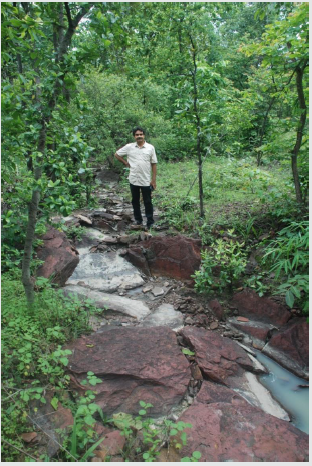
Ed-XRF Technique and Multivariate Analysis
One gram of finely ground powder samples (Sample-1 from Torajunga Trench-III of milling stone, Sample-2 from near the village Kamalga from an ephemeral stream bed, and Sample-3 was collected from recently scrapped sedimentary context), were analysed using a Xenemetrix Energy Dispersive X-ray fluorescence (ED-XRF) spectrometer EX 3600. This is amultielemental analyser consisting of a liquid nitrogen cooled 12.5 mm2 Si (Li) X-ray detector, (150 eV resolution at 59 k EV), a Rh anode X-ray tube (maximum voltage and current being 50kV and 1mA respectively). The analysis was carried out in vacuum at different voltages for optimum detection of most elements high Quantitative analysis was carried out using the inbuilt software, nEXT. NIST soil standard was used as the standard reference material for validating the results. The results of the analysis are shown in the Table 2. The results clearly show counts and concentration of Fe and low counts and concentration of silica (Si) in Sample-1 and 2, while counts and concentration of Fe is much lower and those of silica (Si) is more in case of Sample-2. The colour of the streak is deep purple in case of Sample-1 and 3, while that of Sample -2 is light red. The results of the elemental analysis is presented through heat map and dendrogram (Figure 17). Heat map (Figure 17A) provides intuitive visualization of the data table, where each coloured cell on the map corresponds to a concentration value in data table, with samples in rows and features/compounds in columns. One can use heat maps to identify samples/features that are unusually high or low. The associated dendrogram (Figure 17B) clearly shows that sample-1 and 3 are highly correlated and come under one cluster, whereas sample-2 comes in different cluster. Compounds such as Ba, Fe, Cd, Al, Si, V and K help highly clustering Sample-1 and 3 together. The results clearly reveals that hominins during post-early Middle Palaeolithic period not only exploited the local resources including raw materials like chert, quartz, etc., for manufacturing different types of tools, but they also procured exotic/specialised raw materials , like red ochre from more than 60-70 kilometres away from their settlement area.
Discussion and Conclusion
The foregoing accounts on the investigation at Torajunga of
Bargarh uplands clearly reveals two sets of lithic industries, one
dominated by the use of quartzite as raw material for manufacturing
tools, and another used locally available chert, milky quartz, quartz
crystal for tool production. Notwithstanding exploitation of local
raw material sources, the hominins at Torajunga also imported raw
materials like red ochre from distant sources, as clearly suggested
from our preliminary study. Although red/yellow ochre pigments
have been extensively used in the rock art sites (caves, rock shelters
and huge rocky outcrops) across South Asia, no report has yet been
available on the characterisation of such pigments nor has any
concerted effort been made to trace their sources. In this respect,
the present effort made to establish the source area of red ochre in
relation to archaeological context appears significant. Our recent
investigation in the Bargarh uplands have brought to light a large
number of flake-blade/microlithic assemblages associated with
used/unused red ochre specimens in open-air context, details of
which will be published later. Although scientific date has not yet
been procured from the Early Middle Palaeolithic levels, though
samples from different trenches have been submitted and results
are still awaited, the only available OSL date of 12.8±2.8ka from the
uppermost level of the sedimentary level associated with microliths
from the scrapped section clearly reveals that those occur just
above the Early Middle Palaeolithic level, must be chronologically
much older. In all the excavated trenches at Torajunga flakesblades/
microliths occur just above the deposit containing Early
Middle Palaeolithic artefacts.
The ED-XRF and statistical analyses clearly suggest procurement
of red ochre bocks/nodules from distant sources, like Sundargarh-
Jharsuguda districts border area, geologically represented by
the Kamthi Formation of Gondwana Super Group, which mostly
comprise rocks of sandstone, silt stone, shale and grit. Numerous
rock shelters with Prehistoric-Protohistoric and Early Historic
pictographs and petroglyphs, representing wild as well as domestic
animals, frogs, pangolin, deer, etc., besides an array of symbols of
human foot, palm and female genital organs, and design patterns,
have been documented in this area, majority of which have been
executed in red ochre of different shades [35-38]. Though one
of these rock shelters has been excavated by Pradhan in 1999,
and retrieved microliths, cord-impressed pottery fragments and
used red ochre artefacts, he has not yet published details of his
excavated remains including the red ochre pieces [38]. Thus, more
serious efforts have to be taken from scientific perspectives rather
than broad descriptions of forms/shapes and subject matters
represented on the rock shelter walls/cave.
Although archaeologically, red ochre has been proved to be used
as adhesive for tool hafting and hide processing , besides burial
practices [39-43], ethnographic records reveal use of red ochre or
a variety of purposes, like food preservation, preparation of animal
hides, body decoration, mortuary/ritualistic practices, adhesive/
glue for lithic artefact hafting, insect repellent and also as medicine
[3,4, 44-50]. Use of red ochre at Torajunga and similar other
open-air sites in the Bargarh uplands still remains a significant
question and investigations from multidisciplinary perspectives
are undergoing to resolve this issue. Within the limitations of
the present investigation the present preliminary investigation
would definitely inspire future investigators to adopt scientific
methodologies to determine the source areas of red ochre and
thereby they will be able to understand the human-environment
relationship in India and elsewhere.
Acknowledgements
The authors gratefully acknowledge the Archaeological Survey of India for giving permission to conduct investigation in the study area. The first author is thankful to the administrative and financial support for carrying out the execution of the archaeological investigation in the Bargarh Uplands. Many thanks to our research scholars and Post-Graduate students of Archaeology stream, as well as the villagers of Torajunga and Raisabha for their unflinching help and cooperation.
References
- Barham LS (2002) Systematic Pigment use in the Middle Pleistocene of South-Central Africa. Current Anthropology 43 (1): 181-190.
- Evans U (1994) Hollow Rock Shelter, a Middle Stone Age Site in the Cederberg. South African Field Archaeology 3: 63‐73.
- Watts I (2009) Red ochre, Body Painting, and Language: Interpreting the Blombos Ochre. In: R. Botha and C. Knight (Eds.), The Cradle of Language, Oxford University Press, New York, USA pp 62‐92.
- Watts I (2010) The Pigments from Pinnacle Point Cave 13B, Western Cape, South Africa. Journal of Human Evolution 59: 392‐411.
- Henshilwood CS, Dubreuil B (2009) Reading the Artefacts: Gleaning Language Skills from the Middle Stone Age in Southern Africa. In R. Botha and C. Knight (Eds.) The Cradle of Language, Oxford: Studies in the Evolution of Language, Oxford University Press, United Kingdom p. 41-61.
- Henshilwood CS, et al. (2011) A 100 000 Year‐Old Ochre‐Processing Workshop at Blombos Cave, South Africa. Science 334(6053): 219‐222.
- Mc Brearty S, Brooks AS (2000) The Revolution that was Not: A New Interpretation of the Origin of Modern Human Behaviour. Journal of Human Evolution 39: 453‐563.
- Lombard M (2006) Direct Evidence for the Use of Ochre in the Hafting Technology of Middle Stone Age Tools from Sibudu Cave, KwaZulu‐Natal. Southern African Humanities, 18(1): 57–67.
- Lombard M (2007) The Gripping Nature of Ochre: The Association of Ochre with Howiesons Poort Adhesives and Later Stone Age Mastics from South Africa. Journal of Human Evolution 53: 406–419.
- Lombard M (2009) The Howieson’s Poort of South Africa Amplified. South African Archaeological Bulletin 64: 4–12
- dʹErrico F, Salomon H, Vignaud C, Stringer C (2010) Pigments from the Middle Palaeolithic Levels of Es‐Skhul (Mount Carmel, Israel). Journal of Archaeological Science 37(12): 3099‐3110.
- Soressi M, et al. (2008) Pech‐de‐lʹAzé I (Dordogne, France): Nouveau Regard sur un GisementMoustérien de Tradition AcheuléenneConnuDepuis le XIX Siè In: J. Jaubert, J‐G Bordes and I. Ortega (Eds.) Les sociétés Paléolithiques dʹun Grand Sud‐Ouest: Nouveaux Gisements, NouvellesMéthodes,Nouveaux Résultats, Mémoires de la SociétéPréhistoriquefrançaise, Société Préhistoriquefrançaise, France pp. 95‐132.
- Tr bska J, Ga A, Trybalska B, Fridrichová‐Sýkorová I (2010) Colo ured Raw Materials on the Beov I Site and in the Vicinity: Preliminary Results and Further Perspectives. In: I. Fridrichová‐Sýkorová (Ed.), Ecco homo. In memoriam Jan Fridrich, Krigl: Praha pp. 205‐217.
- Roebroeke WMJ, Trine KN, Dimitri De L, Pares JM, Arps CES, et al. (2012) Use of red ochre by early Neandertals. PNAS 109 (6): 1889-1894.
- D’Errico, Henshilwood C, Vanhaeren M, Niekerk KV (2005) Nassarius Kraussianus Shell beads from Blombos cave: Evidence for symbolic behaviour in the Middle Stone Age. Journal of Human Evolution 48 (1): 3-24.
- Chase P, Dibble H (1987) Middle Palaeolithic Symbolism: A Review of Current Evidence and Interpretation. Journal of Anthropological Archaeology 6: 263‐296.
- Mellars P (1989) Major Issues in the Emergence of Modern Humans. Current Anthropology 30: 349‐385.
- Chase PG (1994) On Symbols and the Palaeolithic. Current Anthropology 35: 627‐629.
- Klein RG (2000) Archaeology and the Evolution of Human Behaviour. Evolutionary Anthropology 9: 17‐36.
- James, H.V. and Petraglia, M.D. (2005) Modern Human Origins and the Evolution of Behavior in the Later Pleistocene Record of South Asia. Current Anthropology, 46: 3‐27.
- Marean CW, Assefa Z (2005) The Middle and Upper Pleistocene African Record for the Biological and Behavioral Origins of Modern Humans. In A.B. Stahl (Ed.) African Archaeology 93‐129.
- Mishra S, Chauhan N, Singhvi AK (2013) Continuity of Microblade Technology in the Indian Subcontinent since 45 ka: Implications for the Dispersal of Modern Humans. PLoS ONE 8(7): 1‐14.
- Clarkson C, Petraglia M, Korisettar K, Haslam M, Boivin N, et al. (2009) The Oldest and Longest Enduring Microlithic Sequence in India: 35 000 Years of Modern Human Occupation and Change at the Jwalapuram Locality 9 Rockshelter. Antiquity 83: 326–348.
- Basak B, Srivastava P, Dasgupta S, Kumar A, Rajaguru SN (2014) Earliest Dates and Implications of Microlithic Industries of Late Pleistocene from Mahadebbera and Kana, Purulia District, West Bengal. Current Science 107(7): 1167–1171.
- Deraniyagala SU (2007) The Prehistory and Protohistory of Sri Lanka. In PL Prematilleke, S Bandaranayake, SU Deraniyagala, R Silva (Eds.), The Art and Archaeology of Sri Lanka, Central Cultural Fund, Colombo, Sri lanka pp. 1–96.
- Perera N (2010) Prehistoric Sri Lanka: Late Pleistocene Rockshelters and An Open Air Site. BAR International Series. Archaeopress, Oxford.
- Perera N, Kourampas N, Simpson IA, Deraniyagala SU, Bulbeck D, et al. (2011) People of the Ancient Rainforest: Late Pleistocene Foragers at the Batadomba‐Lena Rockshelter, Sri Lanka. Journal of Human Evolution 61: 254–269
- Roberts P, Boivin N, Petraglia MD (2015) The Sri Lankan ‘Microlithic’ Tradition C. 38 000 to 3000 Years Ago: Tropical Technologies and Adaptations of Homo Sapiens at the Southern Edge of Asia. Journal of World Prehistory 28: 69‐112.
- Clarkson C, Petraglia M, Harris C, Shipton C, Norman K (2018) The South Asian Microlithic: Homo Sapiens Dispersal and Adaptive Response. In E Robinson and F Sellet (Eds.), Lithic Technological Organization and Palaeoenvironmental Change, Springer International Publishing AG: Studies in Human Ecology and Adaptation 9: 37‐61.
- Thakur N (2015) A Study of Acheulian Industries of Bargarh Upland: With Special Reference to the Jira River Valley, Odisha. Unpublished Ph D dissertation, Sambalpur University, India.
- Behera PK, Thakur N (2019) Tanged points from the Middle Palaeolithic Context at Torajunga, Bargarh Upland, Odisha, India. Man and Environment 44(1): 1-11.
- Swain BB, Ray SB (2007) Report On Regional Survey For Locating Kimberlite/Lamproite Pipe Rocks Along The Upper Reaches Of Mahanadi And Ib Rivers In Parts Of Bargarh, Jharsuguda, Sundargarh, Sambalpur And Sonepur Districts, Orissa. Geological Survey of India, Bhubaneswar, India.
- Geological Survey of India (2002) District Resource Maps: Bargarh, Jharsuguda, Sambalpur and Sundargarh. Geological Survey of India, Kolkata, India.
- Behera PK, Sinha P, Thakur N (2015) Barpadar: An Acheulian Site in the Upper River Jira Basin, District Bargarh, Odisha. Man and Environment 40(1): 1‐ 13.
- Behera PK (1991-92) Prehistoric Rock Art Pertaining to Fertility Cult and Other Subjects of Orissa. Pragdhara 2: 7-17.
- Neumayer E (1992) Rock Pictures in Orissa. Pragdhara 22: 13-24.
- Ota SB (1994) Painted Rock shelter at Manikmoda, Orissa-Revisited. In: HC Das et al. (Eds.) Krishna Pratibha. Studies in Indology, New Delhi, India 1: 17-22.
- Pradhan S (1995) Rock art of Orissa-A study of regional style. Purakala 6 (1-2): 5-13.
- Lombard M (2005) Evidence of Hunting and Hafting during the Middle Stone Age at Sibudu Cave, Kwajulu-Natal, South Africa: A Multianalytical Approach. Journal of Human Evolution 48: 279-300.
- Dubreuil L, Grosman L (2009) Ochre and Hide working at a Natufian Burial place. Antiqity 83 (322): 935-954.
- Rifkin RF (2012) The Symbolic and functional exploration of ochre during the African Middle Stone Age. Unpublished Ph.D. dissertation, University of Witwatersrand, Johannesburg, South Africa.
- Wojcieszak M, Wadley L (2018) Raman spectroscopy and scanning electron microscopy confirm ochre residues on 71,000 year old bifacial tools from Sibudu, South Africa. Archaeometry 60 (8): 1-15.
- Wadley L, Williamson B, Lombard M (2004) Ochre Hafting in Middle Stone Age Southern Africa: A Practical Role. Antiquity 78: 661–675.
- Wadley L, Hodgskiss T, Grant M (2009) Implications for Complex Cognition from the Hafting of Tools with Compound Adhesives in the Middle Stone Age, South Africa. Proc Natl Acad Sci USA 106: 9590–9594.
- Roper DC (1991) A Comparison of Contexts of Red Ochre Use in Paleo‐Indian and Upper Paleolithic Sites. North American Archaeologist 12: 289–301.
- Velo J (1984) Ochre as Medicine: A Suggestion for the Interpretation of the Archaeological Record. Current Anthropology 25: 674.
- Peile AR (1979) Colours that cure. Hemisphere 23: 214–217.
- Basedow H (1925) The Australian Aboriginal. Preece and Sons, Adelaide, Australia.
- Borg G, Jacobson M (2013) Ladies in red-mining and use of red pigment by Himba women in northwestern Namibia. Tagungen Des Landesmuseums for Vorgeschichfe Halle 10: 43-51.
- Mellars P (1989) Major Issues in the Emergence of Modern Humans. Current Anthropology 30: 349‐385.

Top Editors
-

Mark E Smith
Bio chemistry
University of Texas Medical Branch, USA -

Lawrence A Presley
Department of Criminal Justice
Liberty University, USA -

Thomas W Miller
Department of Psychiatry
University of Kentucky, USA -

Gjumrakch Aliev
Department of Medicine
Gally International Biomedical Research & Consulting LLC, USA -

Christopher Bryant
Department of Urbanisation and Agricultural
Montreal university, USA -

Robert William Frare
Oral & Maxillofacial Pathology
New York University, USA -

Rudolph Modesto Navari
Gastroenterology and Hepatology
University of Alabama, UK -

Andrew Hague
Department of Medicine
Universities of Bradford, UK -

George Gregory Buttigieg
Maltese College of Obstetrics and Gynaecology, Europe -

Chen-Hsiung Yeh
Oncology
Circulogene Theranostics, England -
.png)
Emilio Bucio-Carrillo
Radiation Chemistry
National University of Mexico, USA -
.jpg)
Casey J Grenier
Analytical Chemistry
Wentworth Institute of Technology, USA -
Hany Atalah
Minimally Invasive Surgery
Mercer University school of Medicine, USA -

Abu-Hussein Muhamad
Pediatric Dentistry
University of Athens , Greece

The annual scholar awards from Lupine Publishers honor a selected number Read More...




